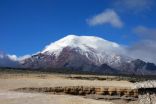Upslope migration of tropical plants due to climate change
The plants on the highest mountain in Ecuador have migrated more than 500 meters to higher altitudes during the last 2 centuries
2015-09-14
(Press-News.org) This news release is available in Spanish.
The plants on the highest mountain in Ecuador have migrated more than 500 meters to higher altitudes during the last two centuries. This is determined in a new study, in which Aarhus University researchers compared Humboldt's data from 1802 with current conditions.
Although most of the world's species diversity is found in tropical areas, there are very few studies that have examined whether tropical mountain species are affected by climate change to the same extent as temperate species. A new study has now determined that major changes have taken place during the last two centuries.
By comparing the migration of plant communities on the Chimborazo volcano in Ecuador with historical data from 1802, Aarhus University researchers found an average upslope shift of more than 500 meters. The entire vegetation boundary has moved upwards from 4,600 meters to almost 5,200 meters. The main explanation for this dramatic shift is climate change over the last 210 years.
In Humboldt's footsteps
The German scientist Alexander von Humboldt traveled to South and Central America around the 1800s to map the distribution of plants and to explore what determines the different vegetation boundaries. He collected plants over a period of many years, and his collections led to a better understanding of the link between climate and species' distributions, which he described in several works. One of his most noteworthy works was the Physical Tableau, a cross-section of the Chimborazo inscribed with the names of the plants he found on the mountainside.
"Humboldt's Tableau and the accompanying descriptions make up the oldest known data set in the world of vegetation along elevation gradients. It provided us with a unique opportunity to study how plant distributions have changed in the tropics during the last two centuries," says Professor Jens-Christian Svenning, Department of Bioscience, Aarhus University, who is one of the authors of the study.
In summer 2012, the team of researchers followed in Humboldt's footsteps to Chimborazo to map the current distribution of the plants. The fieldwork was carried out at an altitude of up to 5,200 meters.
"Right up at 5,185 meters, we found the last trace of vegetation. A defiant little plant belonging to the sunflower family and half covered in snow - in full flower in spite of the cold conditions, the thin air, and the harsh wind," says Naia Morueta-Holme, the lead author of the study. The fieldwork was carried out in connection with her PhD studies at the Department of Bioscience, Aarhus University.
Upward shift of vegetation zones
By comparing the two data sets, it became clear that not only the vegetation growth limit has moved, but also the vegetation zones defined by Humboldt. The individual plant species are now found more than 500 meters upslope than they were 210 years ago. These changes in the vegetation are more than expected as a result of today's warmer climate.
Other studies show that there is now less precipitation in the area, which has also contributed to the significant shrinkage of the glaciers covering the top of the volcano. In addition, the lower parts of the volcano have been intensively cultivated, and a number of species that were previously only found in the lowland near agricultural areas have been introduced by humans.
A combination of human-induced climate change and the direct impact on the plant communities via cultivation of the landscape around the volcano helps explain the large-scale vegetation shift - more than has been experienced in other regions outside the tropics.
Provides insight into the future
The study shows how historical data sets can be used to demonstrate the way nature is already shifting in response to global and local environmental change. This provides insight into what to expect in the future, when climate change is forecast to be even more severe than witnessed in the last two centuries.
"Even though the plants have kept up on average until now, we see many individual species that are lagging behind, while others - especially common species that are good at spreading and living under many different conditions - are moving upslope. We can thus expect even more drastic changes in the vegetation in the future, and there are concerns about how the rare and specialized species will survive - particularly in the tropics, where most of them grow," explains Naia Morueta-Holme.
The results of the study can be used for purposes such as nature conservation by giving high priority to efforts to minimize the direct impact of landscape cultivation.
INFORMATION:
The study is featured in the scientific journal Proceedings of the National Academy of Sciences USA on 14 September 2015.
For more information, please contact:
Postdoctoral Fellow Naia Morueta-Holme
Department of Bioscience, Aarhus University
(now at the University of California Berkeley, USA)
Email: morueta-holme@berkeley.edu
+1 510 701 4390
Professor Jens-Christian Svenning
Department of Bioscience, Aarhus University
Email: svenning@bios.au.dk
+45 2899 2304
ELSE PRESS RELEASES FROM THIS DATE:
2015-09-14
A recently identified molecule produced by skeletal muscle in response to exercise, has been shown to increase bone mass, according to a collaborative study between researchers at the Mount Sinai Bone Program, Icahn School of Medicine at Mount Sinai, the Department of Experimental and Clinical Medicine at University of Ancona in Italy, and the Department of Basic Medical Science, Neuroscience and Sense Organs at the University of Bari in Italy, and published online today in the Proceedings of the National Academy of Sciences (PNAS).
Although exercise is a well known ...
2015-09-14
People with congenital stationary night blindness, or CSNB, have normal vision during the day but find it difficult or impossible to distinguish objects in low light. This rare condition is present from birth and can seriously impact quality of life, especially in locations and conditions where artificial illumination is not available.
Working in collaboration with Japanese scientists, researchers at the University of Pennsylvania have for the first time found a form of CSNB in dogs. Their discovery and subsequent hunt for the genetic mutation responsible may one day ...
2015-09-14
A new study from the Gladstone Institutes shows for the first time that impairments in mitochondria--the brain's cellular power plants--can deplete cellular energy levels and cause neuronal dysfunction in a model of neurodegenerative disease.
A link between mitochondria, energy failure, and neurodegeneration has long been hypothesized. However, no previous studies were able to comprehensively investigate the connection because sufficiently sensitive tests, or assays, were not available to measure ATP (the energy unit of the cell that is generated by mitochondria) in individual ...
2015-09-14
WASHINGTON (Sept. 14, 2015) -- According to initial results of a multi-site landmark study, led by Dominic Raj, M.D., at the George Washington University (GW) site, cardiovascular disease morbidity is significantly reduced through intensive management of high blood pressure.
By targeting a blood pressure of 120 millimeters of mercury (mm Hg), lower than current guidelines, researchers found that adults 50 years and older also significantly reduced their rates of cardiovascular disease and cardiovascular events, such as heart attack and heart failure, as well as stroke, ...
2015-09-14
Humans are extremely choosy when it comes to mating, only settling down and having kids after a long screening process involving nervous flirtations, set-ups by friends, online matchmaking sites, awkward dates, humiliating rejections, hasty retreats and the occasional lucky strike. In the end, we "fall in love" and "live happily ever after." But evolution is an unforgiving force - isn't this choosiness rather a costly waste of time and energy when we should just be "going forth and multiplying?" What, if anything, is the evolutionary point of it all? A new study may have ...
2015-09-14
MRSA is bad news. If you've never heard of it, here's what you need to know: It's pronounced MER-suh, it's a nasty bacterial infection and it can cause serious disease and death.
Senior molecular biology major Jacob Hatch knows MRSA as the infection that took his dad's leg.
Hatch was thousands of miles away on an LDS (Mormon) mission when Methicillin-Resistant Staphylococcus aureus decalcified the bones in his dad's foot and lower leg, leading to an emergency amputation just below the knee.
"It was really hard to hear the news--you never expect to hear someone in ...
2015-09-14
Irvine, Calif., Sept. 14, 2015 -- University of California, Irvine researchers with the School of Medicine have identified the mechanism by which valproic acid controls epileptic seizures, and by doing so, also revealed an underlying factor of seizures.
Valproic acid is widely used to treat various types of seizure disorders, but to this point, the cellular mechanism affected by its anticonvulsant properties were not well understood.
Dr. Naoto Hoshi, an associate professor of pharmacology and physiology & biophysics, and colleagues discovered that valproic acid preserved ...
2015-09-14
Athens, Ga. - Microbiology researchers at the University of Georgia studying a soil bacterium have identified a potential mechanism for neurodegenerative diseases.
A role for the protein HSD10 had been suspected in patients with Alzheimer's disease and Parkinson's disease, but no direct connection had previously been established. This new breakthrough suggests that HSD10 reduces oxidative stress, promotes cell repair and prevents cellular death.
The authors first discovered that an enzyme related to HSD10, CsgA, produces energy during sporulation in the bacterium ...
2015-09-14
A new review has produced the most conclusive evidence to date that people consume more food or non-alcoholic drinks when offered larger sized portions or when they use larger items of tableware. The research, carried out by the University of Cambridge and published in the Cochrane Database of Systematic Reviews, suggests that eliminating larger-sized portions from the diet completely could reduce energy intake by up to 16% among UK adults or 29% among US adults.
Overeating increases the risks of heart disease, diabetes, and many cancers, which are among the leading causes ...
2015-09-14
Single grandparents raising grandchildren are more vulnerable to poor physical and mental health than are single parents, according to a study recently published in Current Gerontology and Geriatrics Research.
These caregivers may be at greater risk for diminished physical capacity and heightened prevalence of depression, researchers found.
Researchers at Georgia State University and the University of Toronto found that solo grandparents caring for grandchildren fare worse than single parents across four critical health areas: physical health, mental health, functional ...
LAST 30 PRESS RELEASES:
[Press-News.org] Upslope migration of tropical plants due to climate change
The plants on the highest mountain in Ecuador have migrated more than 500 meters to higher altitudes during the last 2 centuries




